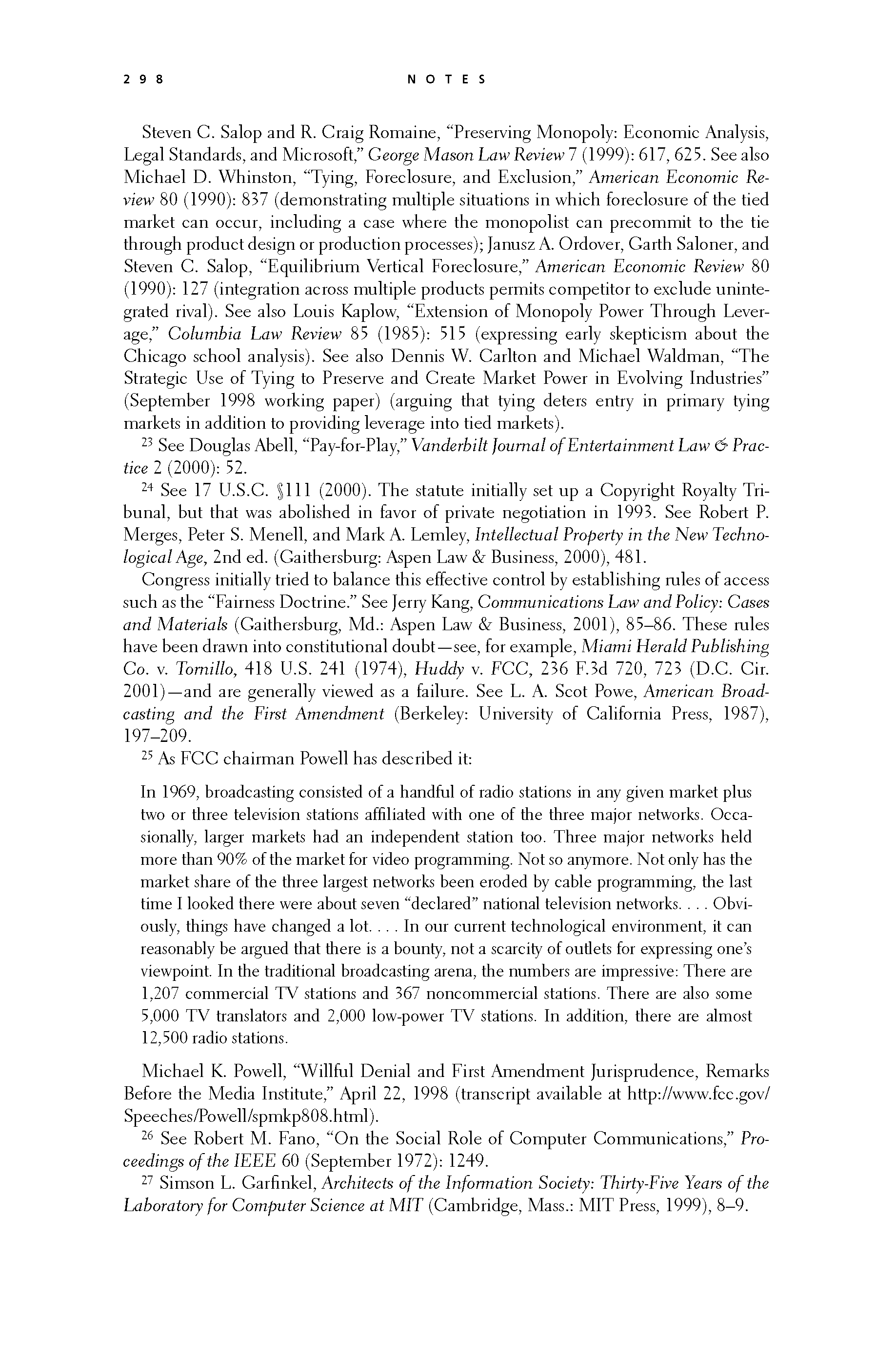 p297 _
-chap- _
toc-1 _
p298w _
toc-2 _
+chap+ _
p299
p297 _
-chap- _
toc-1 _
p298w _
toc-2 _
+chap+ _
p299
Steven C. Salop and R. Craig Romaine, "Preserving Monopoly: Economic Analysis,
Legal Standards, and Microsoft," _George_Mason_Law_Review_ 7 (1999): 617, 625. See also
Michael D. Whinston, "Tying, Foreclosure, and Exclusion," _American_Economic_Re-_
_view_ 80 (1990): 837 (demonstrating multiple situations in which foreclosure of the tied
market can occur, including a case where the monopolist can precommit to the tie
through product design or production processes); Janusz A. Ordover, Garth Saloner, and
Steven C. Salop, "Equilibrium Vertical Foreclosure," _American_Economic_Review_ 80
(1990): 127 (integration across multiple products permits competitor to exclude uninte-
grated rival). See also Louis Kaplow, "Extension of Monopoly Power Through Lever-
age," _Columbia_Law_Review_ 85 (1985): 515 (expressing early skepticism about the
Chicago school analysis). See also Dennis W. Carlton and Michael Waldman, "The
Strategic Use of Tying to Preserve and Create Market Power in Evolving Industries"
(September 1998 working paper) (arguing that tying deters entry in primary tying
markets in addition to providing leverage into tied markets).
[7-23] See Douglas Abell, "Pay-for-Play," _Vanderbilt_Journal_of_Entertainment_Law_&_Prac-_
_tice_ 2 (2000): 52.
[7-24] See 17 U.S.C. #111 (2000). The statute initially set up a Copyright Royalty Tri-
bunal, but that was abolished in favor of private negotiation in 1993. See Robert P.
Merges, Peter S. Menell, and Mark A. Lemley, _Intellectual_Property_in_the_New_Techno-_
_logical_Age,_ 2nd ed. (Gaithersburg: Aspen Law & Business, 2000), 481.
Congress initially tried to balance this effective control by establishing rules of access
such as the "Fairness Doctrine." See Jerry Kang, _Communications_Law_and_Policy:_Cases_
_and_Materials_ (Gaithersburg, Md.: Aspen Law & Business, 2001), 85-86. These rules
have been drawn into constitutional doubt -- see, for example, _Miami_Herald_Publishing_
_Co._ v. _Tornillo,_ 418 U.S. 241 (1974), _Huddy_ v. _FCC,_ 236 F. 3d 720, 723 (D.C. Cir.
2001) -- and are generally viewed as a failure. See L. A. Scot Powe, _American_Broad-_
_casting_and_the_First_Amendment_ (Berkeley: University of California Press, 1987),
197-209.
[7-25] As FCC chairman Powell has described it:
____ In 1969, broadcasting consisted of a handful of radio stations in any given market plus
____ two or three television stations affiliated with one of the three major networks. Occa-
____ sionally, larger markets had an independent station too. Three major networks held
____ more than 90% of the market for video programming. Not so anymore. Not only has the
____ market share of the three largest networks been eroded by cable programming, the last
____ time I looked there were about seven "declared" national television networks... Obvi-
____ ously, things have changed a lot... In our current technological environment, it can
____ reasonably be argued that there is a bounty, not a scarcity of outlets for expressing one's
____ viewpoint. In the traditional broadcasting arena, the numbers are impressive: There are
____ 1,207 commercial TV stations and 367 noncommercial stations. There are also some
____ 5,000 TV translators and 2,000 low-power TV stations. In addition, there are almost
____ 12,500 radio stations.
Michael K. Powell, "Willful Denial and First Amendment Jurisprudence, Remarks
Before the Media Institute," April 22, 1998 (transcript available at http://www.fcc.gov/
Speeches/Powell/spmkp808.html).
[7-26] See Robert M. Fano, "On the Social Role of Computer Communications," _Pro-_
_ceedings_of_the_IEEE_ 60 (September 1972): 1249.
[7-27] Simson L. Garfinkel, _Architects_of_the_Information_Society:_Thirty-Five_Years_of_the_
_Laboratory_for_Computer_Science_at_MIT_ (Cambridge, Mass.: MIT Press, 1999), 8-9.
[[298]]
p297 _
-chap- _
toc-1 _
p298w _
toc-2 _
+chap+ _
p299